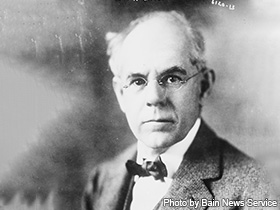You are here

5/25/1860 - 1/20/1944
Renowned psychologist and scholarly editor, James McKeen Cattell was born in Easton.
James McKeen Cattell was born in Easton, Pennsylvania, on May 25, 1860. Cattell moved to Germany and began his studies of psychology there before returning to the United States. While there, he worked with Wilhelm Wundt. Once he returned to the United States, Cattell worked at Johns Hopkins University, the University of Pennsylvania, and Columbia University. After disagreements with the leaders at the universities, Cattell emphasized psychology writing instead of the applied aspects. He started some journals and took over others, and eventually he worked on publishing the journals. Cattell worked on psychology journals and their publication until his death on January 20, 1944.
James McKeen Cattell was born on May 25, 1860, in Easton, Pennsylvania. Cattell began his academic career by studying at Lafayette College and then universities of G??ttingen and Leipzig before receiving a fellowship at Johns Hopkins University in 1882. There he began his work on mental processes but soon lost his fellowship after disagreements with the university's president. Cattell then returned to Leipzig and worked in the field of experimental psychology with Wilhelm Wundt. Cattell was the first American to receive a German Ph.D. in the field in 1886, and was also the first American to publish a dissertation in psychology. Afterwards, he returned from Europe and contributed a great deal to the strengthening of American psychology. Cattell later moved to Cambridge, England, in order to work at St. John's College. A few years later, he married Josephine Owen, a woman he had met while in Leipzig. While there, he studied the differences between individuals. In 1889 Cattell moved again to become a professor at the University of Pennsylvania. There he began two sets of experiments and did work with biologist Charles S. Dolly and philosopher George S. Fullerton.
In 1891, Cattell moved to Columbia University. There he began to use "mental tests" to study individuals. He used quantitative data but never considered outside factors affecting individuals' performance. Because he did not consider this outside information, his tests were not considered useful and his ideas were abandoned by others. Although a lot of his ideas were not well supported, Cattell was still successful as a psychologist. In 1893, Cattell had a daughter named Psyche who eventually grew up to be a prominent psychologist as well. She was one of his students and learned a lot from him. Cattell taught Psyche to study in the field of intelligence and she eventually worked on an infant intelligence test which was an extension of the Stanford-Binet.
Cattell was the first psychologist elected to the National Academy of Sciences in 1901. Soon thereafter, Cattell began to gradually withdraw from laboratory work and started to concentrate on his literary work. During his psychological work, Cattell founded many of the major psychological publications of the time. He founded the Psychological Corporation and the Science Press. He also was an editor of psychological journals, including The Psychological Review and the Journal of Science. Although Cattell did a lot of work helping to start psychology journals, he did not write very much in them. Instead, he concentrated on the editing and publishing aspects of them in order to further the view of psychology as a science. Throughout his life, Cattell pushed to have psychology viewed as a science just like the physical sciences. In 1900, Cattell took over Popular Science Monthly and eventually changed the name to Scientific Monthly. He continued to take over different journals for years in order to promote his views and help others. By working as an editor for the different journals, Cattell was able to decide what types of articles were published in his journals. He was able to use the journals as a means of promoting that view.
In 1917, Cattell was fired from Columbia University for opposing the United States' conscription policy during World War I. Years later he sued the university and won an annuity. In 1921, he used the money that he had gained from the settlement in order to start the Psychological Corporation to foster his interest in the field of applied psychology. Because he was never able to really explain how psychologists can apply their work, the organization failed until taken over by other psychologists who had experience in applied psychology. Towards the end of his life, Cattell still edited and published his journals. To help himself in the process, he created the Science Press Printing Company in order to produce his journals. He continued his work on the journals until his death in 1944 in Lancaster, Pennsylvania.
Books
- An Education in Psychology: James McKeen Cattell's Journal and Letters from Germany and England, 1880-1888. (with James McKeen and Michael M. Sokal) Cambridge: MIT Press, 1981.
- University Control. New York: Science Press, 1913.
Journals Edited
- Psychological Review (1894-1904).
- Popular Science Monthly (1900-1915).
- Science Monthly (1915-1940s).
- American Men of Science (1905-1930s).
- American Naturalist (1907-1930s).
- Baron, Jonathan. "Cattell at Penn." University of Pennsylvania: Department of Psychology. 21 Apr. 2005. 29 Jan. 2006. <>http://www.psych.upenn.edu/history/cattelltext.htm>.
- Brozek, Josef. Explorations in the History of Psychology in the United States. Lewisburg: Bucknell UP, 1984.
- "Human Intelligence: James McKeen Cattell." Indiana University. 4 Jan. 2006. 29 Jan. 2006. <>http://www.indiana.edu/~intell/jcattell.shtml>.
- "Human Intelligence: Psyche Cattell." Indiana University. 14 July 2004. 28 Feb. 2006. <>http://www.indiana.edu/~intell/pcattell.shtml>.
- Sokal, Michael M. "Cattell, James McKeen." American National Biography Online. Feb. 2000. 22 Jan 2006. <>http://www.anb.org/articles/14/14-00101.html>.
Photo Credit: Bain News Service. "American psychologist, psychology professor, editor, and publisherˇJames McKeen Cattell.." Photography. Licensed under Public Domain. cropped to 4x3. Source: Wikimedia. Library of Congress, Prints and Photographs Division, George Grantham Bain Collection.
